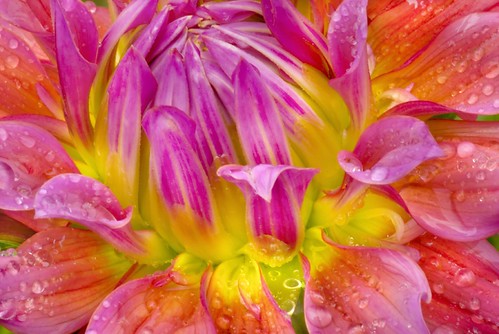I ordered some bare-root dahlias from Swan Island Dahlias, and planted them in the late spring. This is a photo, taken at f/64 for maximum depth-of-field in sunlight in my garden, of one of the first serious flowers from these dahlia plants.
The aperture, f/64, is one of the smallest available lens apertures and therefore provides the greatest depth-of-field. How small an aperture you can use depends upon the specifics of individual lenses, and f/64 is more typical of a large format lens than a dSLR lens. I’m fortunate to own an 85mm manual lens that will stop down to f/64.
Group f/64 included Ansel Adams, Imogen Cunningham, and Edward Weston and took its name from the aperture f/64, because of the high depth-of-field the tiny aperture implies. In the minds of group members, this great depth-of-field implied a certain style of photography. As the f/64 manifesto put it:
The name of this Group is derived from a diaphragm number of the photographic lens. It signifies to a large extent the qualities of clearness and definition of the photographic image which is an important element in the work of members of this Group.
…
Group f/64 limits its members and invitational names to those workers who are striving to define photography as an art form by simple and direct presentation through purely photographic methods. The Group will show no work at any time that does not conform to its standards of pure photography. Pure photography is defined as possessing no qualities of technique, composition or idea, derivative of any other art form.
At this point, a disclaimer. As much as I love the work of many of the great photographers who were part of Group f/64, my own work does not hold to the stated Group f/64 principles. In some cases I strive to echo and reference non-photographic artists, e.g., Escher, Nolde, and Hokusai.
Digital photography, I believe, takes the dialog of what photography is (or should be) one step further from “pure photography”. The techniques of digital post-processing surely do resemble those of painting, drawing, and other art forms. (For more on this, see my essays When Is a Photograph Not a Photograph? and Myths, Metaphors, and Digital Photography.)
One strand of thought about contemporary photography is to insist that the only authentic photo is the image as shot by the camera. For instance, a recent contest run by National Geographic Magazine requires submission of only the “original, unmodified camera image”. (Somewhat oddly, the contest prize is a chance to see your photo reproduced in National Geographic. Regarding digital modification of photos, one can assume that National Geographic applies the same strictures to its staff photographers.)
As a matter of aesthetics, I love the work of many of the Group f/64 photographers. However, the philosophic posture of Group f/64 is limiting. (OK, I know the manifesto was a response to insipid and derivative pseudo-painterly imagery.) With the advent of digital, and the possibility of introducing an incredible visual wealth into photography, the posture is insupportable and stifles creativity. Nationnal Geographic (and others) get this one wrong.
More dahlia photos: Wet Dahlia, Dahlia Days, my Dahlia set on Flickr.

Pingback: Photoblog 2.0: » Photoblog 2.0 Archive: » Shine a Light on Digital Photography